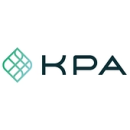It’s one thing to have employees send money or goods to an organization — but enabling them to see the impact of their efforts firsthand changes everything.
For instance, when Environmental Health and Safety Regional Director Amanda Rawls utilizes her paid volunteer time off at KPA, she gets to truly immerse herself in supporting others in person and makes a point to bring others along so they can have the same enriching experience.
“I like that I can spend a workday at my Central Texas Food Bank and invite my nieces and nephews to come with me, so I can inspire and show them the importance of spending your time on others — away from your phone,” she said.
For Rawls, being able to carve out time in her work calendar to give back to her community in person has been a game-changer, enabling her to prioritize what matters most. Senior Digital Marketing Manager Marie Mason has had a similar experience at Scaled Agile, where she and her peers use their paid volunteer time to take part in various outreach efforts, such as volunteering at mobile food markets.
She believes that her company’s commitment to social impact doesn’t just make it easy to help those in need; it also brings her and her teammates closer together.
“Working alongside 15 coworkers outside of the office lets me see sides of them that just don’t come through in our virtual meetings,” Mason said.
At KPA and Scaled Agile, community service opportunities empower employees to support those in need — and build meaningful connections with each other. Read on to see what else Rawls and Mason had to say about the impact of their companies’ volunteer efforts and what they think leaders at other organizations should do to boost their outreach opportunities.

Scaled Agile offers Scaled Agile Framework solutions, which are designed to help organizations and government agencies identify and deliver customer value, capitalize on emerging opportunities and improve business outcomes.
Describe how Scaled Agile gives back to its communities. What impact do these efforts have on both those in need and employees themselves?
At Scaled Agile, I’m proud of how we integrate giving back into our company culture. We believe strongly in supporting the communities where we live and work, recognizing that it enriches both our neighborhoods and our team members’ lives. Our volunteer time off program gives every employee 16 paid hours annually to volunteer, eight hours to connect with teammates in a volunteer setting, and eight hours to support personal causes. This makes community service accessible without sacrificing personal time.
For example, about 15 coworkers and I volunteered at mobile food markets through We Don’t Waste. In just two markets, we served quality, reclaimed food to over 700 families. Additionally, we can submit proposals to our 1% Pledge committee, which gives back quarterly to employee-selected charities. The results have been powerful. Our communities receive direct support, financial contributions and business expertise, while our team members develop new skills and build stronger connections with their communities.
How do these community outreach efforts bolster Scaled Agile’s mission and culture?
Our community outreach efforts directly strengthen Scaled Agile’s mission and culture in meaningful ways. These volunteer experiences create powerful bonds among team members that are especially valuable in our virtual work environment. When my colleagues and I distribute reclaimed food to families through We Don’t Waste or build bikes and deliver them to local schools, we connect face-to-face in ways that virtual meetings simply can’t replicate. Working alongside 15 coworkers outside of the office lets me see sides of them that just don’t come through in our virtual meetings. You get to know people differently when you’re distributing food, building bikes or collecting school supplies together instead of discussing deadlines during calls.
“You get to know people differently when you’re distributing food, building bikes or collecting school supplies together instead of discussing deadlines during calls.”
The shared purpose and hands-on teamwork during these volunteer events translate to more authentic collaboration and connection when we return to our regular work. We get to know each other as people, not just faces on a screen. The employee-driven nature of our 1% Pledge program further reinforces our culture of empowerment. By allowing us to propose causes for quarterly donations, Scaled Agile recognizes we’re closest to our communities’ needs.
How Scaled Agile Has Supported its Communities
- American Red Cross donation after Hurricanes Milton and Helene
- The Ocean Cleanup donation that helps preserve the world’s waterways
- Maui Strong Fund following the Maui Fires
- Donations and matching donations within Boulder county after the 2021 Marshall Fire
- Serving re-claimed, high-quality food to more than 1,000 families through We Don’t Waste mobile markets over the last few years
What advice would you offer to leaders at other organizations interested in implementing more volunteer opportunities? Which efforts have had the biggest impact at Scaled Agile?
If you’re thinking about adding more volunteering at your company, here’s what’s worked well for us at Scaled Agile:
Give people dedicated time to volunteer. Our 16 hours of paid volunteer time off, split between company events and personal volunteering, gives people flexibility while ensuring participation.
Focus on in-person activities when you can, especially with remote teams. There’s just something different about working alongside colleagues to build bikes for kids or distribute food that builds relationships in ways Zoom can’t touch.
Let employees choose the causes. When we submit ideas for our 1% Pledge donations, it creates real ownership and ensures our giving reflects what actually matters to our team.

KPA’s solutions are designed to enable organizations to identify, remedy and prevent workplace safety and compliance issues.
Describe how KPA gives back to its communities. What impact do these efforts have on both those in need and employees themselves?
KPA gives back to the community in a variety of ways, and what I like best is that employees have a choice in how we give back. KPA employees have two paid volunteer days to use annually, which can be used however you like. That volunteer time can be spent on projects that have a personal meaning, around the holidays, used alongside your friends or family, or as a group event organized by employees. The volunteer days were inspired by a young KPA field consultant, Brandon Baker, who passed away unexpectedly. Brandon volunteered with kids and youth programs regularly, so giving back was the best way KPA could honor him.
To strengthen our volunteer options, KPA has partnered with Percent Pledge. Monthly volunteer opportunities are highlighted through the company’s platform, which can be completed virtually or in person. It allows you to find both local events and public charities and recognizes your personal volunteer time. Percent Pledge plants a tree for every volunteer hour logged, and KPA often matches donations, which doubles our impact. KPA also has a DEI committee that puts a spotlight on different cultures and communities. Speakers and lunch-and-learn sessions are scheduled for employees to learn and grow together.
How do these community outreach efforts bolster KPA’s mission and culture?
KPA’s mission is to build an environment based on respecting our talented colleagues’ individual experiences and mutual respect for our customers and partners regardless of color, religion, ethnicity and sexual orientation. Through the lens of DEI, our mission is to make meaningful contributions to celebrate our differences and learn from each other, uniting us in an open and accepting culture that acknowledges everyone’s workplace safety as well as their physical and psychological safety.
KPA employees feel seen and recognized. I appreciate having the opportunity to give back with my team as part of an organized volunteer event but also on my own. I like that I can spend a workday at my Central Texas Food Bank and invite my nieces and nephews to come with me, so I can inspire and show them the importance of spending your time on others — away from your phone. I love that Percent Pledge will highlight virtual volunteer opportunities that I can pick to fit into my day with time that I am already spending on my computer. Those projects have included everything, from screening resumes to helping with scientific research by spotting pictures and listening to sounds.
“I like that I can spend a workday at my Central Texas Food Bank and invite my nieces and nephews to come with me, so I can inspire and show them the importance of spending your time on others — away from your phone.”
What advice would you offer to leaders at other organizations interested in implementing more volunteer opportunities? Which efforts have had the biggest impact at KPA?
I would vote to empower your employees and value their time and contributions. It can be hard for employees to know where to start, so as a company, become a leader that provides options for team and individual contributions. Community impact events can be as small as an office canned food drive and a YouTube speaker to highlight an upcoming holiday. They can also be highly organized, ultra-glossy events. Community impact and volunteering have to be prioritized and recognized by company leaders. Do not offer paid volunteer days while simultaneously discouraging your employees from using them. Back up your offer. Remind people regularly that this resource is available.
At KPA, we utilize Slack, our company newsletter and town hall events to highlight the time and projects that employees contribute to. Our #Community Slack channel is an easy way to show your experience and remind others to make time to give back. As a manager, I will organize a volunteer event for my team in a region, and we’ll spend the day together as a team volunteering together. We always leave fulfilled and with a full cup, recharged and ready to give back again.









